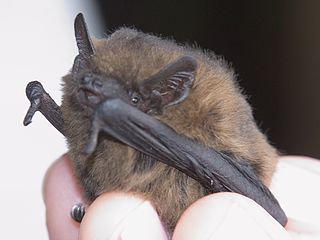
Pipistrellus is a genus of bats in the family Vespertilionidae and subfamily Vespertilioninae. The name of the genus is derived from the Italian word pipistrello, meaning "bat".

The tricolored bat is a species of microbat native to eastern North America. Formerly known as the eastern pipistrelle, based on the incorrect belief that it was closely related to European Pipistrellus species, the closest known relative of the tricolored bat is now recognized as the canyon bat. Its common name "tricolored bat" derives from the coloration of the hairs on its back, which have three distinct color bands. It is the smallest bat species in the eastern and midwestern US, with individuals weighing only 4.6–7.9 g (0.16–0.28 oz). This species mates in the fall before hibernation, though due to sperm storage, females do not become pregnant until the spring. Young are born helpless, though rapidly develop, flying and foraging for themselves by four weeks old. It has a relatively long lifespan, and can live nearly fifteen years.

The common pipistrelle is a small pipistrelle microbat whose very large range extends across most of Europe, North Africa, South Asia, and may extend into Korea. It is one of the most common bat species in the British Isles. In Europe, the northernmost confirmed records are from southern Finland near 60°N.

The soprano pipistrelle is a small species of bat. It is found in Europe and often roosts on buildings.

The Japanese house bat or Japanese pipistrelle is a species of vesper bat. An adult has a body length of 3.6–4.8 cm (1.4–1.9 in), a tail of 2.9–4.0 cm (1.1–1.6 in), and a wing length of 3.2–3.6 cm (1.3–1.4 in). It prefers to roost under the ceiling or inside the roof of old buildings. It is found across East Asia, from China and Taiwan into the Ussuri region, the Korean Peninsula, and Japan.
The Mount Gargues pipistrelle is a species of vesper bat found in Kenya and believed to be widely distributed across highlands in Ethiopia. It typically lives in subtropical or tropical forests.
The angulate pipistrelle, also known as the New Guinea pipistrelle, is a species of vesper bat found in Papua New Guinea and the Solomon Islands.

Kelaart's pipistrelle is a species of vesper bat found in southern and south-eastern Asia from Pakistan to Indonesia.

Endo's pipistrelle is a species of vesper bat that is endemic to Japan. It is found in temperate forests.

The Mount Popa pipistrelle is a species of vesper bat. It is found in China, India, Myanmar, Thailand, and Vietnam.

The least pipistrelle is a species of vesper bat.

The Arabian pipistrelle is a species of vesper bat in the family Vespertilionidae. It is found only in Iran and Oman.

The Cape serotine is a species of vesper bat occurring in Sub-Saharan Africa. 'Serotine' is from Latin 'serotinus' meaning ‘of the evening'.

The Indian pipistrelle is a species of bat in the family Vespertilionidae found in Afghanistan, Bangladesh, Bhutan, Cambodia, India, Myanmar, Nepal, Pakistan, Sri Lanka, Thailand, and Vietnam.

The cave nectar bat, dawn bat, common dawn bat, common nectar bat or lesser dawn bat is a species of megabat within the genus Eonycteris. The scientific name of the species was first published by Dobson in 1871.

The Christmas Island pipistrelle was a species of vesper bat found only on Christmas Island, Australia. The species is now extinct, with the last individual bat seen in August 2009 with no further sightings despite intensive efforts to locate it.
Rousettus bat coronavirus HKU9 (HKU9-1) is an enveloped, positive-sense, single-stranded RNA mammalian Group 2 Betacoronavirus discovered in Rousettus bats in China in 2011. This strain of coronavirus is closely related to the EMC/2012 strain found in London which is related to the Middle East respiratory syndrome-related coronavirus (MERS-CoV). The MERS-CoV species is responsible for the 2012 Middle East respiratory syndrome coronavirus outbreak in Saudi Arabia, Jordan, United Arab Emirates, the United Kingdom, France, and Italy.

Pipistrellini is a tribe of bats in the family Vespertilionidae. It contains several genera found throughout the Old World and Australasia, including the pipistrelles, noctules and related species.
















